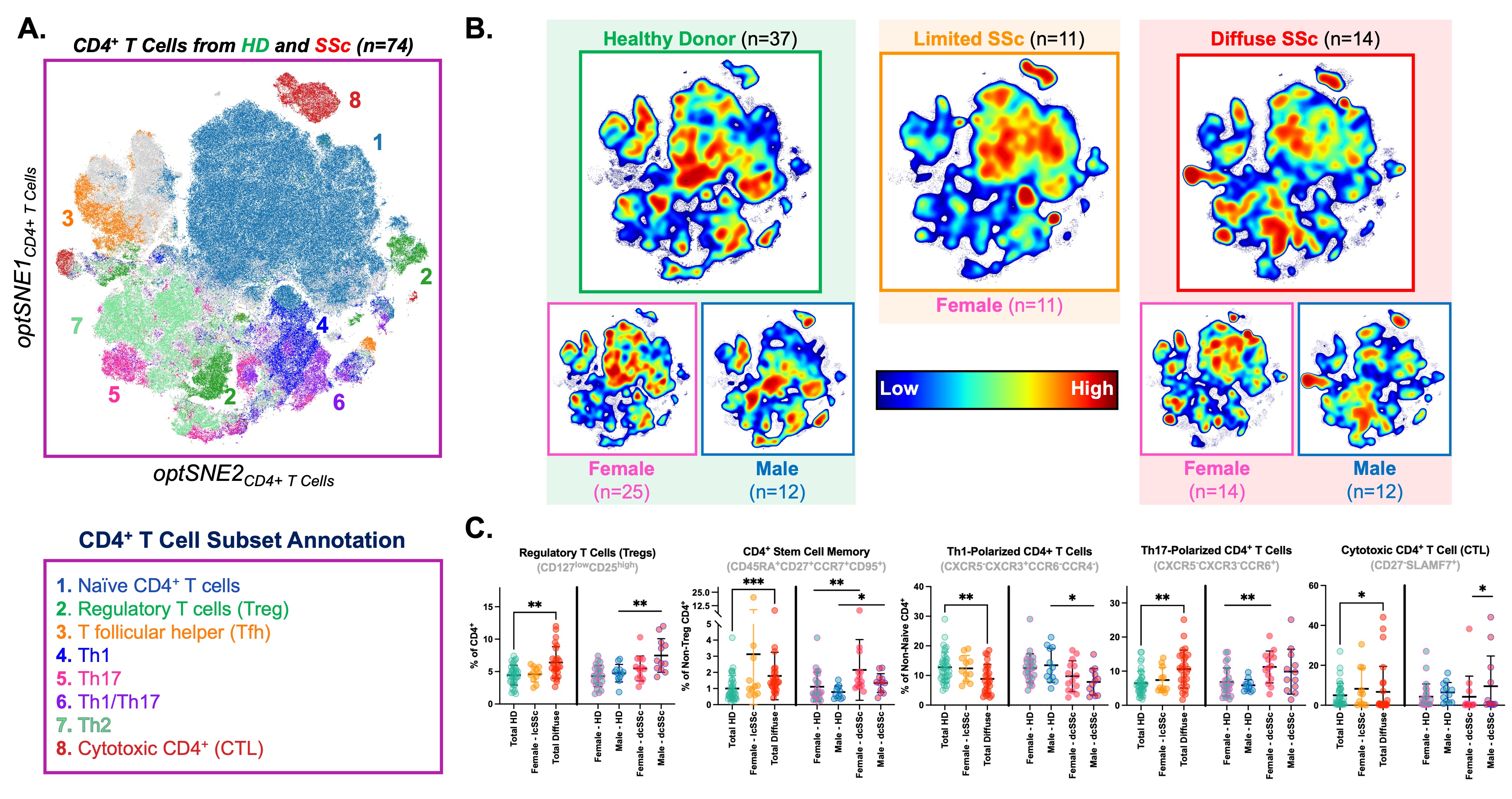Session Information
Date: Saturday, November 16, 2024
Title: Abstracts: Systemic Sclerosis & Related Disorders – Basic Science
Session Type: Abstract Session
Session Time: 1:00PM-2:30PM
Background/Purpose: Systemic sclerosis (SSc) is a heavily female-biased systemic autoimmune disease associated with significant morbidity and mortality due to fibrosis of the skin and vital internal organs. Though females are much more susceptible to SSc than males, afflicted males tend to exhibit more severe disease. The immunological basis of these sex biases is unclear and has not been studied previously. We report the first investigation of sex differences in the circulating immune landscape in patients with SSc.
Methods: We developed a 30-color flow cytometry panel based on existing literature regarding circulating immune cells implicated in SSc. This panel identifies broad immune cell subsets and more deeply profiles lymphocyte subsets. Using a 5-laser Cytek Aurora Analyzer, we performed 30-color spectral flow cytometry on peripheral blood mononuclear cells from patients with lcSSc (n=11 female) and dcSSc (n=26; n=14 female, n=12 male) and sex-, age-, and race-matched healthy donors (n=37). Data were analyzed via manual gating and via unbiased dimensionality reduction and FlowSOM clustering using the OMIQ cytometry analysis platform. Statistical comparisons were performed between disease state and health, and between female and male sex within a given group.
Results: All patients with SSc fulfilled the 2013 ACR Classification Criteria for SSc. Most specimens (82% lcSSc; 64% dcSSc-female, 58.3% dcSSc-male) were obtained during the “early disease” phase, defined as sample collection within 3 years of disease diagnosis. Anti-Scl70 was the most frequently observed autoantibody in females (84.6%) and males (70.0%) with dcSSc. The frequency of immunosuppression at the time of sample acquisition was similar in females (57.1%) and males (58.3%) with dcSSc, and slightly lower in patients with lcSSc (45.5%). Overall, we observed many more changes in the proportion of circulating immune cell subsets in patients with dcSSc compared to lcSSc. Patients with dcSSc exhibited markedly decreased proportions of circulating CD56+ natural killer cells and increased proportions of both CD4+ and CD8+ stem cell memory T cells, independent of biological sex or immunosuppression. Patients with dcSSc also exhibited an expansion of Th17-polarized CD4+ T cells and a contraction of Th1-polarized CD4+ T cells, and these differences were primarily driven by afflicted females and afflicted males, respectively. Males with dcSSc exhibited many unique immune cell subset changes compared to afflicted females, including increased proportions of classical monocytes, plasmacytoid dendritic cells, activated (CD38+HLADR+) CD4+ and CD8+ T cells, and cytotoxic (SLAMF7+CD27–) CD4+ T cells, as well as reduced proportions of total B cells.
Conclusion: We identified sex differences in relevant circulating immune cell subsets that are uniquely apparent amongst patients with dcSSc. Validation of these findings using an orthogonal cohort and additional studies examining sex differences within immune cellular transcriptional programs, both in the periphery and within fibrotic tissues, are underway, and will help clarify how sex differences in the abundance and function of specific immune cells uniquely contribute to SSc susceptibility and severity.
To cite this abstract in AMA style:
Posso S, Buckner J, Anguera M, Jiwrajka N. 30-Color Full Spectrum Flow Cytometry Identifies Sex Differences in the Circulating Immune Landscape of Systemic Sclerosis [abstract]. Arthritis Rheumatol. 2024; 76 (suppl 9). https://acrabstracts.org/abstract/30-color-full-spectrum-flow-cytometry-identifies-sex-differences-in-the-circulating-immune-landscape-of-systemic-sclerosis/. Accessed .« Back to ACR Convergence 2024
ACR Meeting Abstracts - https://acrabstracts.org/abstract/30-color-full-spectrum-flow-cytometry-identifies-sex-differences-in-the-circulating-immune-landscape-of-systemic-sclerosis/



